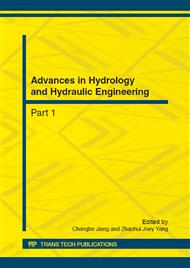p.241
p.245
p.253
p.260
p.264
p.268
p.272
p.278
p.283
Study on Hillslope Hydrodynamics Process and Catchment Runoff Producing Pattern in Humid Area
Abstract:
Hydrologic cycle was the supporter of pollution matter transportation, and the transferring of agricultural non-point source pollution from land to water has great relationship with hydrologic process. As part study of agricultural non-point source pollution matter transferring mechanics in small watershed, we studied the soil water movement, overland flow producing and confluence mechanism at the hillslope and watershed scales during storm events in humid area. This study monitored the overland flow, soil moisture, groundwater and the stream flow at outlet of the watershed during two storm events (July 19th 2008 and July 30th 2009), analyzed the rain-runoff producing patterns under different conditions and their impact factors. In humid area, soil water movement had three patterns, rainfall infiltration, lateral subsurface flow and groundwater rising, their ranges of influence depths were decided by the rainfall amount, duration and intensity, antecedent conditions and the soil physical characteristics. The overland runoff was infiltration excess runoff at the leading portion of the event, and changed gradually into the mixed patterns of infiltration excess runoff and saturation excess runoff. There was a large amount of regression water on the falling limb of the stream flow. The sources of the stream flow at the outlet of watershed contributed much to the non-point source pollution transportation pathways.
Info:
Periodical:
Pages:
264-267
Citation:
Online since:
October 2012
Authors:
Price:
Сopyright:
© 2012 Trans Tech Publications Ltd. All Rights Reserved
Share:
Citation:


